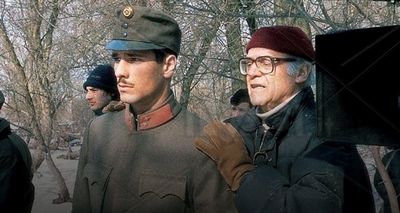Maribor: the Retrospective in the former ECOC

East / West – The current ECOC GO! 2025 on a cinematic visit to the former ECOC Maribor 2012
On Thursday, 27 November, the current European Capital of Culture GO! 2025 will make a cinematic stop in Maribor, the city that held this title in 2012. At the Intimni kino GT22, located at Glavni trg 22 in Maribor, Kinoatelje will present the retrospective East / West: The Border Through Film and History. Kinoatelje is the conceptual author and artistic–production lead of the retrospective, a programme it actively co-develops film events throughout the entire year as part of the European Capital of Culture GO! 2025. The event is organised by the association Društvo za razvoj filmske kulture Maribor, with the financial support of the Municipality of Maribor, and includes the participation of the Slovenian Film Critics’ Association FIPRESCI, which will contribute a lecture within the Kritiški popotnik project.
The programme will begin at 19:00 with the presentation of a publication created as part of the research for the East / West retrospective. At 19:45, a screening of Mak Sajko’s film Where Is the Iron Curtain? (1961) will follow, contextualised by a lecture from film critic and documentarian Majda Širca. At 21:00, the evening will conclude with the Slovenian premiere of the digitised copy of Franco Giraldi’s film The Border (La frontiera, 1996). Admission is free.
The East / West retrospective is part of the official programme of the European Capital of Culture GO! 2025. The project aims to present to European audiences the rich cinematographic heritage of the Slovenian–Italian cross-border region. The films, exploring life along this border, challenge the conventional notion of borders as mere lines of separation, instead depicting them as dynamic spaces of transition, exchange and connection.
The film selection includes a diverse range of feature films, documentaries, animated works and newsreels that reflect the multilayered experiences of life in multicultural regions where people of different nationalities coexist and enrich one another’s lives. It also focuses on themes that mirror both the historical and contemporary experience of the cross-border space and offers insights relevant to many intercultural environments across Europe.
The East / West retrospective, which will travel through various European cities in 2025, will be enriched by additional discussions and presentations by historians, sociologists, film theorists and filmmakers. These perspectives will highlight the experiences of communities and individuals and illuminate how to recognise and harness the strengths of multicultural regions.

Where Is the Iron Curtain?
Mako Sajko, Slovenia (Yugoslavia), 1961, 12 min
The short documentary focuses on life along the Yugoslav-Italian border in the 1960s. In a humorous way, it depicts daily life and neighborly relations in the border region, where trade between the two countries flows almost uninterrupted. The film dispels myths about the impermeable border between the "Eastern and Western blocs" and prophetically predicts the eventual end of the tightly controlled border.
“I filmed things that I knew were far from photogenic but could carry a valuable message. Through my films, I told stories about things we can improve. This is the role of documentary filmmaking.” - Mako Sajko

The Border (La frontiera)
Franco Giraldi, Italy, 1996, 107 min
The film follows the parallel stories of two young Dalmatians: Habsburg officer Emidio Orlich deserts in the winter of 1916 to fight alongside the Italians against Austria; in the summer of 1941, Lieutenant Franco Velich of the Italian army returns to his birth island, which is also Emidio's birthplace. He returns as an Italian officer recovering from battles in North Africa. The island, once part of Yugoslavia, is now occupied by the Italian army, a situation Franco experiences uncomfortably. While staying on the island, he clashes with Emidio's mother and niece, whose story was told to him by Simeone, a wise old man who looks at the current situation with detachment, but with little hope. The film explores the issue of identity as something violently imposed.
“On the border, no one is born with a ‘single identity’… When the plurality of identities found in border regions is subjected to the desire to reduce it to only one, it can lead only to conflict, tragedy, massacres…” — Franco Giraldi
Kritiški popotnik — The Critical Traveller
The purpose of this project, developed with the financial support of the Slovenian Film Centre, is to decentralise the Slovenian film landscape, especially film criticism. Film critics, who due to strong centralisation mostly work and live in the capital, have decided to pack their bags, set out on the road, and bring film criticism to cinemas across Slovenia. In doing so, they meet face-to-face with film enthusiasts who do not have access to the privileges of centralised film offerings. While film criticism is disappearing from newspapers, television screens and radio broadcasts, it thrives best in direct, two-way exchanges of opinions — in the social setting of a film discussion that follows a shared screening, which is also one of the fundamental missions of film art. This year, the project has already visited Maribor and Idrija, and in early December it will also be hosted at the Mali Union cinema in Celje.



